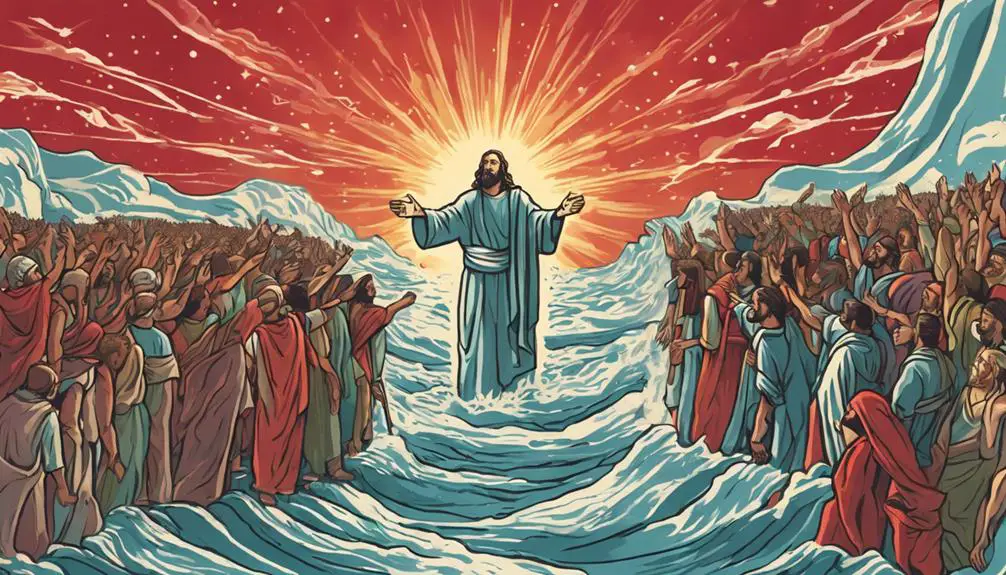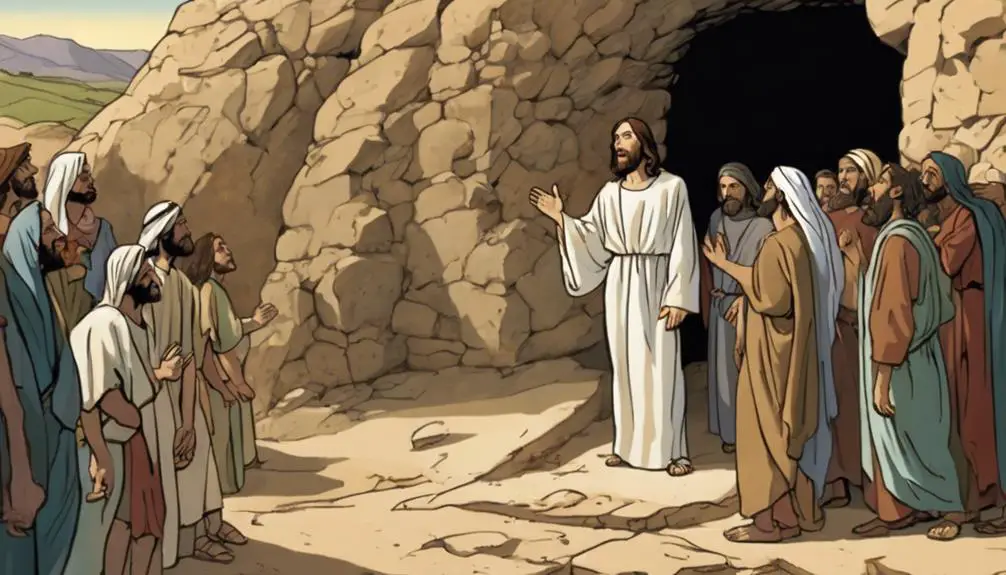Explore the extraordinary miracles across the Old and New Testament, unveiling divine acts that defy explanation and ignite faith.

Miracles in the Bible Old and New Testament
As a tapestry weaves together threads of various colors and textures to create a masterpiece, so do the miracles in the Bible thread through the Old and New Testaments, showcasing the divine power and plan.
You're invited on a journey through time, from the creation of the world to the resurrection of Lazarus, where you'll witness the parting of the Red Sea, Daniel's unwavering faith in the lion's den, and Jesus feeding five thousand with merely five loaves and two fish.
Each story holds a key, revealing layers of meaning and divine purpose. Let's explore these miraculous events, where you'll find intrigue and inspiration that might just transform your understanding of faith and the power beyond what's visible to the eye.
Key Takeaways
- Miracles demonstrate divine power, from creation to intervention in human affairs.
- Faith often plays a pivotal role in experiencing and interpreting miracles.
- Miracles serve to teach lessons of compassion, provision, and the triumph of life over death.
- Both Old and New Testaments depict miracles as signs of God's presence and care.
Creation of the World

In the biblical narrative, God initiates the creation of the world, demonstrating a profound act of divine power that sets the stage for all subsequent events. This momentous act isn't just a display of might but also a meticulous establishment of cosmic order and divine craftsmanship. You're presented with a universe meticulously crafted, from the vast expanses of the heavens to the intricate details of the earth and its inhabitants. This act of creation, as depicted, is a deliberate process, highlighting the intentionality behind the cosmos' formation.
The narrative emphasizes the sequential and thoughtful nature of creation, suggesting that every element, from the light that pierces darkness to the myriad forms of life, is a product of divine will. You're invited to perceive the world as a masterpiece of divine craftsmanship, where chaos is sculpted into order, and life is breathed into matter. This perspective offers a foundational understanding of the world's inherent orderliness and the divine origin of its existence. Through this lens, the act of creation serves as the ultimate testament to the power and wisdom of the creator, establishing a precedent for the miraculous within the biblical narrative.
Parting of the Red Sea
Among the myriad of divine interventions within the biblical narrative, the parting of the Red Sea stands as a paramount demonstration of God's power to alter the natural order for the deliverance of the Israelites. Under Moses' leadership, the Israelites faced the critical moment of escape from the Egyptian pursuit, culminating in a miraculous crossing that has been celebrated and analyzed throughout generations.
To create imagery in the audience's mind:
- Vast waters parting seamlessly, creating a pathway of dry land.
- The Israelites' awe-struck faces as they witness the impossible become possible.
- The relentless Egyptian army, chariots and soldiers, in hot pursuit.
- The dramatic collapse of the water walls, engulfing the Egyptian forces.
- Moses' steadfast faith and calm command in the face of nature's upheaval.
This event not only marked a pivotal moment in the journey of the Israelites from slavery to freedom but also exemplified the theme of divine intervention in response to faith and leadership. The parting of the Red Sea serves as a compelling narrative element that underlines the power dynamics between the oppressed and their oppressors, showcasing the extent of divine willingness to intervene on behalf of the chosen people.
Daniel in the Lion's Den

The narrative of Daniel in the Lion's Den exemplifies another profound instance of divine intervention, where faith under duress leads to miraculous preservation. This story, deeply embedded in Judeo-Christian tradition, isn't merely about survival but symbolizes the triumph of faith and integrity over adversity. Lion's symbolism in this context is multifaceted, representing both the ferocity of Daniel's adversaries and the power of divine protection.
Analyzing the text, you uncover that Daniel's faith isn't passive; it's an active, living testament to his unwavering trust in God, even when faced with death. This aspect is crucial, emphasizing that Daniel's deliverance wasn't due to his own cunning or strength but his steadfast faith. The lions, then, serve not only as instruments of potential execution but as entities that underscore the magnitude of Daniel's faith and the power of divine intervention.
Scholars argue that this narrative serves a dual purpose: it's a historical account of faith's victory over persecution and a theological treatise on the nature of divine protection. Daniel's story, thus, isn't just an isolated miracle but a lesson in the power of unwavering faith amidst life's most daunting challenges.
Jesus Feeds the Five Thousand
Shifting focus to the New Testament, we encounter another profound demonstration of divine provision: Jesus feeding the five thousand. This event not only showcases Jesus' ability to perform miracles but also highlights his divine compassion towards humanity. Analyzing this miracle, we uncover layers of meaning behind the multiplying loaves, which serve as a testament to the boundless generosity of the divine.
- *A vast multitude, gathered in a remote place, finds themselves hungry as evening approaches.*
- *Jesus, upon seeing the crowd, feels compassion for them and decides to act.*
- *With just five loaves and two fish, Jesus orchestrates a feast, defying natural limitations.*
- *The disciples distribute the food, witnessing firsthand the miracle of multiplication.*
- *Finally, twelve baskets of leftovers are collected, symbolizing abundance beyond immediate need.*
This narrative, rich in imagery and significance, demonstrates a crucial aspect of divine compassion: the care for both physical and spiritual nourishment. The act of multiplying loaves not only addresses the immediate hunger of the crowd but also offers a deeper symbolic meaning, illustrating the limitless nature of divine provision. Through this analysis, the miracle emerges as a pivotal demonstration of Jesus' power and compassion, inviting further reflection on its implications for understanding divine care in human lives.
Resurrection of Lazarus

In an unparalleled display of divine power, Jesus' resurrection of Lazarus from the dead not only defies natural laws but also profoundly underscores the theme of life conquering death within the New Testament narrative. This miracle, more than just a demonstration of Jesus' authority over life and death, serves as a pivotal moment that deepens the understanding of faith and the afterlife.
Lazarus' faith, although not explicitly detailed during the event, is implied through his sisters' belief in Jesus' power and their subsequent actions. The tomb visitation by Jesus is a critical moment that showcases the depth of human sorrow juxtaposed with divine intervention.
Aspect |
Description |
Implication |
|---|---|---|
Lazarus' Faith |
Implied through familial belief |
Underlines trust in divinity |
Tomb Visitation |
Jesus' deliberate approach to Lazarus' resting place |
Symbolizes confronting death |
Divine Authority |
Commanding Lazarus to come forth |
Illustrates power over death |
Public Reaction |
Mixture of awe and belief among witnesses |
Spreads Jesus' teachings |
Thematic Depth |
Life conquering death |
Central to Christian belief |
Analyzing the resurrection of Lazarus reveals layers of meaning, from the demonstration of Jesus' divine authority to the thematic exploration of life, death, and faith within the Christian doctrine.
Frequently Asked Questions
How Do Theologians and Scholars Reconcile the Miracles Described in the Bible With Modern Scientific Understanding?
To reconcile biblical miracles with science, you'd explore philosophical implications and employ methodological skepticism. This approach allows you to critically assess narratives while respecting their spiritual significance.
Instead of dismissing these events outright, you'd analyze them through a scholarly, objective lens. This means understanding miracles as part of a broader theological context, acknowledging the limits of human knowledge, and considering the role of faith in interpreting these extraordinary accounts.
Are There Any Documented Miracles in the Bible That Are Considered to Have a Historical Basis Outside of Religious Texts?
Diving into the realm of history, you're hunting for truths veiled in time. You're seeking archaeological evidence and historical verification for events that defy ordinary explanation.
While many stories stand without concrete external support, a few have whispers of confirmation in the sands of archaeology and ancient texts. Yet, it's crucial to tread carefully, as the line between historical fact and faith-based narrative often blurs, leaving room for scholarly debate and interpretation.
How Do Different Christian Denominations Interpret the Purpose and Significance of Miracles in the Bible?
You'll find that denominational interpretations of miracles vary widely. Some view them as literal events showcasing God's power, while others see them as allegorical lessons.
The significance analysis also differs; for some, miracles are central to faith's validation, for others, they're less about proving divinity and more about moral or spiritual lessons.
Essentially, how miracles are understood reflects deeper theological positions and teachings within each Christian denomination.
What Role Do Miracles Play in the Development of Faith and Belief Systems in Judaism and Christianity?
In analyzing the role of miracles in shaping faith and belief systems, you'll find that miracle ethics and faith dynamics intricately intertwine.
Miracles aren't just supernatural events; they're pivotal in challenging and reaffirming beliefs.
For both Judaism and Christianity, miracles serve as a foundation for faith, illustrating divine intervention and bolstering communal belief.
They're essential in understanding how these religions perceive divine power and its interaction with humanity.
Have There Been Any Recent Claims or Reports of Miracles That Are Comparable to Those Found in the Bible, and How Are These Viewed by Religious and Secular Communities?
You're looking for a needle in a haystack when searching for recent miracle claims comparable to biblical times. Miracle skepticism is high in both religious and secular communities, as proof standards have evolved.
Nowadays, you're expected to provide empirical evidence for such phenomena. This analytical scrutiny means many claims don't hold water under the magnifying glass of modern skepticism, leading to a more cautious acceptance of purported miracles.
Conclusion
In analyzing biblical miracles, from Creation's cosmic commencement to Lazarus's life-restoring revival, one discerns a divine design demonstrating deity's dominion. These miracles, manifesting in both Testaments, transcend mere marvels; they're theological touchstones teaching trust, testing tenacity, and tethering the temporal to the transcendent.
Whether it's seas splitting or sustenance shared, each act articulates an aspect of the Almighty's attributes. Thus, these narratives, nestled in sacred scriptures, serve not solely as supernatural spectacles but as spiritual signposts, guiding humanity's gaze Godward.



Sign up